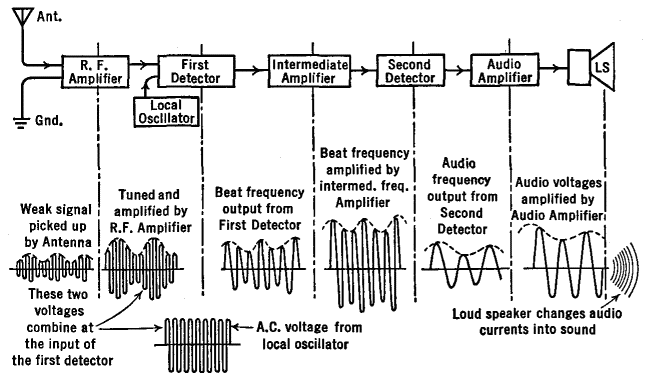| Basic Radio is a free introductory textbook on electronics based on tubes. See the editorial for more information.... |

|

Home  Transmission of Signals Transmission of Signals  Receivers Receivers  The Superheterodyne Receiver The Superheterodyne Receiver |
||||||






|
||||||
|
The Superheterodyne ReceiverAuthor: J.B. Hoag The essential idea of the superheterodyne receiver is to change the radio frequency of the signal to a lower, fixed value, where the amplifying circuits can be designed to have great stability and gain, and proper selectivity and fidelity. These circuits constitute the intermediate frequency (i.f.) amplifier. They operate at a frequency above (super) audibility, say at 455,000 cycles per second. The change of frequency just before the i.f. amplifier is accomplished by a beat or heterodyne circuit, called a frequency-converter. This contains a local-oscillator and the first-detector or mixer. The sequence of circuits in a "superhet" is shown in Fig. 32 G.
The r.f. amplifier ahead of the converter is sometimes called the preselector. Figure 32 H shows the action of the circuit when receiving a c.w. signal.
Suppose that two transmitting stations simultaneously delivered equal-strength r.f. signals to the converter stage, and that the carrier frequency of one is 1,500 kHz, that of the other 2,410 kHz. Then, with the local oscillator set at 1,955 kHz, a beat-note of 455 kHz (1,955 — 1,500) would be produced by one station and a beat-note of 455 kHz (2,410 — 1,995) would be produced by the other. With an i.f. amplifier set at 455 kHz, both stations would "come in" in equal strength at the same time and a jumble of sounds would come out of the loudspeaker. If it is intended that only one signal be received at a time, say the lower, at 1,500 kHz, then the other at 2,410 kHz (or image frequency) must be eliminated. This is accomplished by means of the preselector. The preselector furnishes selectivity and eliminates undesired signals whose frequencies differ appreciably from that at resonance; the i.f. amplifier rejects frequencies which differ but slightly from that at resonance. The image frequency always differs from the desired signal frequency by an amount equal to twice the intermediate frequency. If equal strength signals (desired and image frequency) are applied to the converter, the ratio of the output voltages is called the signal-to-image-ratio, or image-ratio. Within limits, the higher the i.f., the higher the image-ratio. Practically all good preselector circuits give high image-ratios. Spurious reception can be had from beats with harmonic frequencies of both the received signal and the local oscillator. Proper preselector circuits and good shielding, especially in the converter stage, to prevent stray pick-up, will eliminate these undesired effects. For very high frequencies, the incoming frequency is sometimes reduced with a converter to a lower r.f. (1.5, 5, or 10 MHz.) and this, after amplification, is again lowered to the usual 455 kHz. The receiver is then called a double superheterodyne or double-detection receiver.
|
||||||
Home  Transmission of Signals Transmission of Signals  Receivers Receivers  The Superheterodyne Receiver The Superheterodyne Receiver |
||||||
Last Update: 2011-03-27



